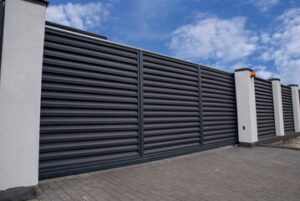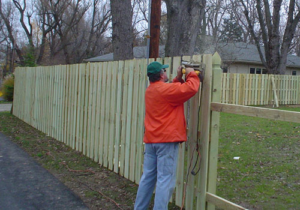A quality fence can make your space secure, define it, and boost your home’s value. But building one takes time, skill, and a willingness to get your hands dirty.

Be honest with yourself about how much of your time you’re willing to commit. And make sure to research the specific care requirements of different fence materials. Contact Summerville Fence Co. for professional help.
Professional fence installation can save you time, money, and potential legal headaches down the road. It requires the right tools and equipment to prepare the site, dig holes, and secure posts. It also requires experience and specialized knowledge to ensure your fencing complies with local regulations. Most importantly, it must be done correctly to create a functional and aesthetically pleasing structure.
Correct construction starts with a careful evaluation of the property lines where the fence will be built. This may involve hiring a surveyor to accurately mark the intended fencing area. It also involves researching and understanding local regulations such as zoning laws, homeowners’ association rules, and fencing setbacks. These regulations can vary from state to state and can significantly impact the final product.
Once the property is surveyed and the required regulations are understood, the actual fence construction begins. Taking accurate measurements is critical to building a fence that will not only demarcate your property boundaries, but will be safe and stable. It also includes constructing the correct bracing assembly that will support your fence and keep it standing strong for years to come. The corner and end post assemblies are the foundation of your entire fence system and should be constructed carefully according to your plan.
After the corners and end posts are set, the horizontal rails can be attached between them. These should be aligned and level to maintain the structural integrity of your new fence. Once the rails are in place, the pickets or panels can be affixed to them. This is where your fence will really begin to take shape and add to the beauty of your home.
Once the fence is completed, regular inspections are important to identify any minor issues and address them promptly. This is especially important for wood fences, as early detection can prevent rot and deterioration. Reapplying stain or sealant every 2-3 years helps protect the wood from moisture and UV rays, and extend its lifespan. This process is also a great opportunity to address any broken planks, loose nails, or any signs of damage from the elements.
Repair
Fences are built to withstand the elements, but time and weather can cause damage that may require repair services. Damaged fences not only affect a property’s curb appeal, but they can also pose safety hazards and reduce security. Common problems include warped panels, sagging posts, broken slats and leaning fences.
A professional can spot these issues and resolve them before they compromise the structural integrity of a fence, protecting the safety of those who use it. They can also repair damaged gates, ensuring that they latch and open properly and safely.
The type of fence material and the severity of the damage will determine what type of repair service is needed. For example, chain link fences can often be repaired by tightening loose bolts and repairing sections of rusted mesh. However, wood and vinyl fences may need to be re-staining or sealed to protect them from moisture and insects.
Repair services can also include replacing rotting or broken boards, but it is important to ensure that the new materials match those in the rest of the fence. A professional will be able to spot the best lumber to replace existing boards and use corrosion-resistant screws or nails to keep them in place. They will also make sure that the replacement boards are evenly spaced for a uniform appearance.
While wood remains a popular choice for residential fencing, it is susceptible to weathering and rot. It can also be affected by insect infestations, such as termites and carpenter ants. If the infestation is severe, the affected boards may need to be replaced with new ones.
Keeping up with regular maintenance is the best way to prevent costly repairs. This includes regularly cleaning a wood fence with mild soap and water to remove dirt buildup. A wood fence should be stained or sealed every few years to protect it from the elements and prolong its lifespan.
It is also important to inspect a fence after significant weather events and address any problems right away. This will help to ensure that minor issues don’t turn into major repairs, such as a leaning fence that could fall on someone walking by.
Maintenance
There are many benefits to installing a fence for your home, from aesthetic appeal to security. For homeowners with pets, a fence provides an effective barrier against stray animals and can help keep them safe and contained. Fences can also provide additional privacy for households living near noisy neighbors or busy streets. In addition, a well-maintained fence can reduce energy costs by providing an extra layer of insulation for your home.
If you are considering installing a new fence for your home, it is important to choose a contractor with extensive experience and knowledge of the industry. A reputable professional will be able to offer insight into the pros and cons of various materials, as well as guide you towards a style that complements your property and overall architecture. The right choice can increase your home’s curb appeal and even add to its resale value down the road.
In addition to enhancing your home’s visual appeal, fencing is an effective deterrent against theft and vandalism. A fence can also protect your yard from the elements, keeping it cool in summer and warm in winter. It is important to invest in high-quality materials and professional installation to ensure that your fence lasts for as long as possible.
A fence can also enhance your curb appeal by establishing your property boundaries and providing a sense of stately grandeur. The right design can be as simple or elaborate as you desire, with a wide range of colors and finishes to match your preferences. In addition, you can choose to include decorative features such as finials or scrolls.
While a new fence can increase your home’s value, it also requires periodic maintenance to keep it looking its best. Traditional wooden fences require regular sanding, staining, and painting to retain their appearance and structural integrity. Vinyl fences, on the other hand, require minimal upkeep, with a simple cleaning with soap and water usually sufficient to maintain their beauty.
A fence can also clearly delineate your property lines, preventing conflicts with neighbors who may be encroaching on your yard space or not mowing their lawn properly. Moreover, a fence can protect your garden, plants, and pets from wild animals such as deer and bears.
Design
Fences are used to define boundaries, provide security, and enhance the aesthetic of residential and commercial property. They can be constructed from a variety of materials, including wood, vinyl, composite, chain link, and steel. Fence services can help you choose the right fencing for your needs and install it to your specifications. They also offer design services that can improve the overall look of your yard and home, creating a harmonious and functional outdoor space.
Whether you want to create an outdoor retreat, keep children and pets safe around the pool, or simply enhance your property’s aesthetic, fences can be a valuable investment for homeowners and businesses alike. Choosing the right fence for your property will ensure privacy, safety, and security, while also providing a high level of visual appeal. When designing your custom fence, consider any future changes or expansions you may wish to make. This will prevent expensive and time-consuming modifications down the road.
A fence can be made from a variety of materials, and you can also choose the height and length that best suit your property. You can even add features like gates to control entry and exit. When selecting a fencing material, consider its durability, strength, and cost. A fence contractor can help you select the right material for your needs and recommend the best options based on your property’s dimensions and budget.
Steel fences are highly durable and can withstand harsh weather conditions. However, they require regular maintenance to maintain their appearance and functionality. A steel fence service can repair or replace worn components and apply a protective coating to minimize the risk of corrosion. The service can also perform routine inspections to monitor rust and prevent damage.
When designing a steel fence, it is important to think about your aesthetic and safety requirements. Choose a steel fence color that complements your landscape, and consider adding decorative elements such as a gate or mailbox post. You can also use plantings to add color and texture to the yard, making your steel fence more attractive and inviting.
